The Voigt pipe is a type of loudspeaker enclosure that embodies a combination of transmission line, ported enclosure and horn characteristics. It is highly regarded by some speaker designers, as evidenced by established manufacturers such as Castle. Due to its relatively high efficiency the design is frequently employed in full-range loudspeaker designs.
The concept is that the sound emitted from the rear of the loudspeaker driver is progressively reflected and absorbed along the length of the tapering tube, almost completely preventing internally reflected sound being re-transmitted through the cone of the loudspeaker. The lower part of the pipe acts as a horn while the top can be visualized as an extended compression chamber. The entire pipe can also be seen as a tapered transmission line in inverted form, that is, widening rather than narrowing from top to bottom. The driver is usually positioned close to the middle of the baffle or slightly lower. Its relatively low adoption in commercial speakers can mostly be attributed to the large resulting dimensions of the speaker produced and the expense of manufacturing a rigid tapering tube.
The Voigt pipe was designed in 1934 by Paul G. A. H. Voigt and is also referred to as a tapered quarter-wave pipe (TQWP) or tapered quarter-wave tube (TQWT).

A subwoofer is a loudspeaker designed to reproduce low-pitched audio frequencies, known as bass and sub-bass, that are lower in frequency than those which can be (optimally) generated by a woofer. The typical frequency range that is covered by a subwoofer is about 20–200 Hz for consumer products, below 100 Hz for professional live sound, and below 80 Hz in THX-certified systems. Thus, one or more subwoofers are important for high-quality sound reproduction as they are responsible for the lowest two to three octaves of the ten octaves that are audible. This very low-frequency (VLF) range reproduces the natural fundamental tones of the bass drum, electric bass, double bass, grand piano, contrabassoon, tuba, in addition to thunder, gunshots, explosions, etc.

A loudspeaker is a combination of one or more speaker drivers, an enclosure, and electrical connections. The speaker driver is an electroacoustic transducer that converts an electrical audio signal into a corresponding sound.

An audiophile is a person who is enthusiastic about high-fidelity sound reproduction. The audiophile seeks to achieve high sound quality in the audio reproduction of recorded music, typically in a quiet listening space in a room with good acoustics.
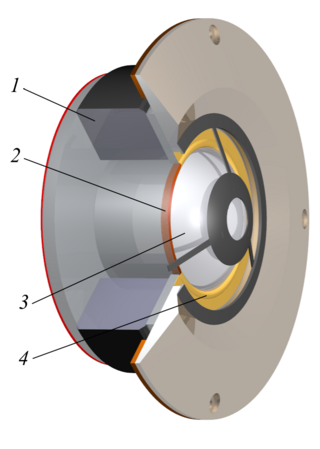
A tweeter or treble speaker is a special type of loudspeaker that is designed to produce high audio frequencies, typically up to 100 kHz. The name is derived from the high pitched sounds made by some birds (tweets), especially in contrast to the low woofs made by many dogs, after which low-frequency drivers are named (woofers).
A woofer or bass speaker is a technical term for a loudspeaker driver designed to produce low frequency sounds, typically from 20 Hz up to a few hundred Hz. The name is from the onomatopoeic English word for a dog's deep bark, "woof". The most common design for a woofer is the electrodynamic driver, which typically uses a stiff paper cone, driven by a voice coil surrounded by a magnetic field.
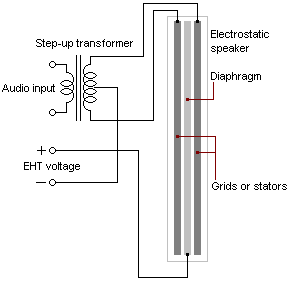
An electrostatic loudspeaker (ESL) is a loudspeaker design in which sound is generated by the force exerted on a membrane suspended in an electrostatic field.

A horn loudspeaker is a loudspeaker or loudspeaker element which uses an acoustic horn to increase the overall efficiency of the driving element(s). A common form (right) consists of a compression driver which produces sound waves with a small metal diaphragm vibrated by an electromagnet, attached to a horn, a flaring duct to conduct the sound waves to the open air. Another type is a woofer driver mounted in a loudspeaker enclosure which is divided by internal partitions to form a zigzag flaring duct which functions as a horn; this type is called a folded horn speaker. The horn serves to improve the coupling efficiency between the speaker driver and the air. The horn can be thought of as an "acoustic transformer" that provides impedance matching between the relatively dense diaphragm material and the less-dense air. The result is greater acoustic output power from a given driver.
Klipsch Audio Technologies is an American loudspeaker company based in Indianapolis, Indiana. Founded in Hope, Arkansas, in 1946 as 'Klipsch and Associates' by Paul W. Klipsch, the company produces loudspeaker drivers and enclosures, as well as complete loudspeakers for high-end, high-fidelity sound systems, public address applications, and personal computers.
A bass reflex system is a type of loudspeaker enclosure that uses a port (hole) or vent cut into the cabinet and a section of tubing or pipe affixed to the port. This port enables the sound from the rear side of the diaphragm to increase the efficiency of the system at low frequencies as compared to a typical sealed- or closed-box loudspeaker or an infinite baffle mounting.
Bowers & Wilkins, commonly known as B&W, is a British company that produces consumer and professional loudspeakers and headphones. The company was founded in 1966 in Worthing, West Sussex, England. In October 2020, it was acquired by Sound United, a holding company who owns several other audio brands.
An acoustic horn or waveguide is a tapered sound guide designed to provide an acoustic impedance match between a sound source and free air. This has the effect of maximizing the efficiency with which sound waves from the particular source are transferred to the air. Conversely, a horn can be used at the receiving end to optimize the transfer of sound from the air to a receiver.
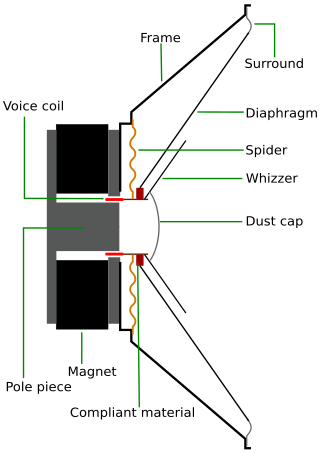
A full-range loudspeaker drive unit is defined as a driver which reproduces as much of the audible frequency range as possible, within the limitations imposed by the physical constraints of a specific design. The frequency range of these drivers is maximized through the use of a whizzer cone and other means. Most single driver systems, such as those in radios, or small computer speaker designs, cannot reproduce all of the audible frequencies or the entire audible audio range.
An acoustic waveguide is a physical structure for guiding sound waves, i.e., a waveguide used in acoustics.
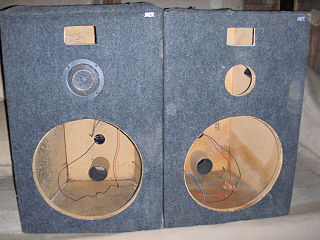
A loudspeaker enclosure or loudspeaker cabinet is an enclosure in which speaker drivers and associated electronic hardware, such as crossover circuits and, in some cases, power amplifiers, are mounted. Enclosures may range in design from simple, homemade DIY rectangular particleboard boxes to very complex, expensive computer-designed hi-fi cabinets that incorporate composite materials, internal baffles, horns, bass reflex ports and acoustic insulation. Loudspeaker enclosures range in size from small "bookshelf" speaker cabinets with 4-inch (10 cm) woofers and small tweeters designed for listening to music with a hi-fi system in a private home to huge, heavy subwoofer enclosures with multiple 18-inch (46 cm) or even 21-inch (53 cm) speakers in huge enclosures which are designed for use in stadium concert sound reinforcement systems for rock music concerts.

A guitar speaker is a loudspeaker – specifically the driver (transducer) part – designed for use in a combination guitar amplifier of an electric guitar, or for use in a guitar speaker cabinet. Typically these drivers produce only the frequency range relevant to electric guitars, which is similar to a regular woofer type driver, which is approximately 75 Hz — 5 kHz, or for electric bass speakers, down to 41 Hz for regular four-string basses or down to about 30 Hz for five-string instruments.

An acoustic transmission line is the use of a long duct, which acts as an acoustic waveguide and is used to produce or transmit sound in an undistorted manner. Technically it is the acoustic analog of the electrical transmission line, typically conceived as a rigid-walled duct or tube, that is long and thin relative to the wavelength of sound present in it.
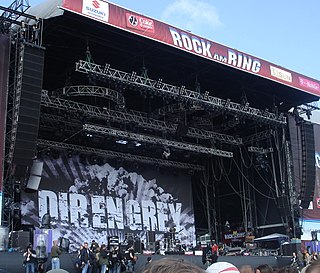
A line array is a loudspeaker system that is made up of a number of usually identical loudspeaker elements mounted in a line and fed in phase, to create a near-line source of sound. The distance between adjacent drivers is close enough that they constructively interfere with each other to send sound waves farther than traditional horn-loaded loudspeakers, and with a more evenly distributed sound output pattern.

An electrodynamic speaker driver, often called simply a speaker driver when the type is implicit, is an individual transducer that converts an electrical audio signal to sound waves. While the term is sometimes used interchangeably with the term speaker (loudspeaker), it is usually applied to specialized transducers that reproduce only a portion of the audible frequency range, or to the one or more drivers within a loudspeaker cabinet. For high fidelity reproduction of sound, multiple loudspeakers are often mounted in the same enclosure, each reproducing a different part of the audible frequency range. In this case the individual speakers are referred to as drivers and the entire unit is called a loudspeaker. Drivers made for reproducing high audio frequencies are called tweeters, those for middle frequencies are called mid-range drivers, and those for low frequencies are called woofers, while those for very low bass range are subwoofers. Less common types of drivers are supertweeters and rotary woofers.
A coaxial loudspeaker is a loudspeaker system in which the individual driver units radiate sound from the same point or axis. Two general types exist: one is a compact design using two or three speaker drivers, usually in car audio, and the other is a two-way high-power design for professional audio, also known as single-source or dual-concentric loudspeakers. The design is favored for its compactness and behavior as an audio point source.
A transmission line loudspeaker is a loudspeaker enclosure design which uses the topology of an acoustic transmission line within the cabinet, compared to the simpler enclosures used by sealed (closed) or ported designs. Instead of reverberating in a fairly simple damped enclosure, sound from the back of the bass speaker is directed into a long damped pathway within the speaker enclosure, which allows far greater control and use of speaker energy and the resulting sound.